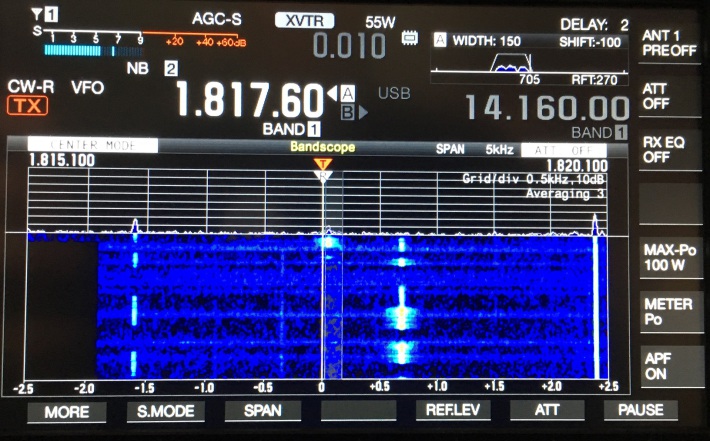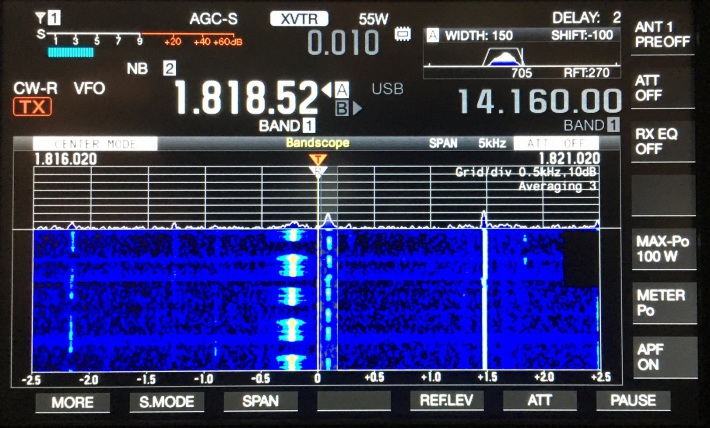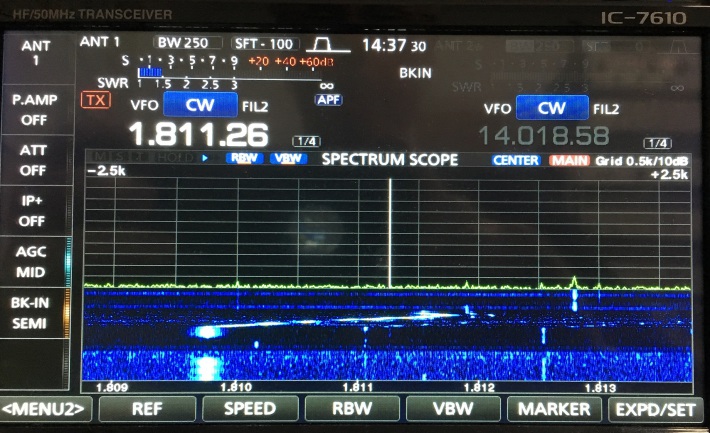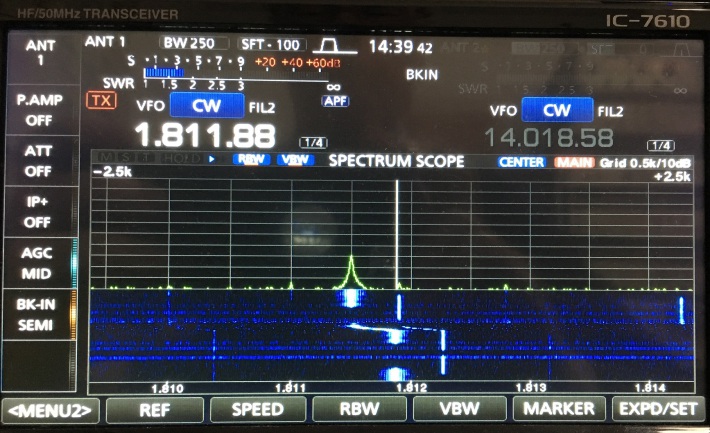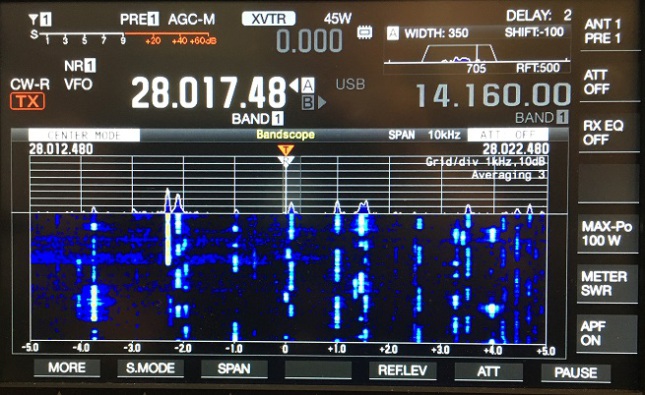Kenwood TS-890S vs. ICOM IC-7610
In the 2018 CQWW DX SSB Contest and ARRL 160m CW Contest
By Rob Sherwood, NC0B
Icom IC-7610 & Kenwood TS-890S Contest Comparisons Oct/Nov/Dec 2018
The Kenwood TS-890S was picked up at HRO Denver 10 days before the October CQWW SSB contest. The Kenwood was at operating position #2 with an Alpha 89 linear, and was operational the weekend before the contest. No setup problems had to be resolved, and the 890S and N1MM+ worked perfectly after the initial setup parameters were saved to the program.
Operating position #1 was an Icom IC-7610, driving an Alpha 99 linear. All operating positions log to a common N1MM+ database. Operating position #3 with an IC-7300 and Acom 1000 was setup to cover 10 meters, but no contacts were made on that band during CQWW.
Since the Icom had been used in four previous contests, both SSB and CW, it was decided to use the new Kenwood on 15 and 20 meters, assigning the Icom to 40 meters and a minimal effort on 80 meters. No contacts were attempted on 160m.
15 meters was used as long as the band was open, and the QSO rate was good, before moving to 20 meters. Only after 20 meters was dead did I move to 40 meters.
As expected with the current sun spot cycle, 20 meters was the “money band”, with 293 Qs on 20, 178 Qs on 15, and only 70 Qs on 40m made with the Icom. Virtually all operation was S&P (search and pounce), as it was very difficult to establish a run on 15, let alone 20 meters. 40m was a struggle to Europe, with better results early on Saturday and Sunday mornings to the Pacific.
Both the Kenwood and Icom rigs have excellent laboratory numbers, and performed as expected. Selectivity was never an issue with either rig, as the DSP bandwidths are easily adjusted to the conditions. On SSB the splatter component of an adjacent-channel station, (odd-order intermodulation), is the limitation of reception of weak signals next to strong adjacent signals. When the splatter is in the receiver’s passband, selectivity is not the issue.
Operational Comparisons:
Both the Kenwood and the Icom performed to expectations as to basic operation. The biggest difference, other than the current price, is the 7610 has dual receivers while the 890S has only one receiver. At least in the way I run contests, non-assisted, and no SO2R, the second receiver doesn’t come into play very often. DXpeditions that always run split are a different matter.
I worked two stations with the Kenwood who were operating split, “up 5 kHz”. I simply used the XIT feature, called the stations, and worked them on the first call. With the Icom on 40 meters I only worked one station transmitting below the US phone band and listening above 7200 kHz. I worked him on the first call.
The ergonomics of the 890S are very similar to the 990S that I used for three years before a lightning EMP damaged the 990S. That made transitioning from the 990S to the 890S very easy.
Due to the high signal density, both rigs were run with a 2.1 kHz bandwidth for the bulk of the contest. The bandscopes on both rigs cannot display very weak signals that can be copied by ear. The “grass” on the Kenwood scope can be minimized by using the maximum averaging setting of 3. This helps on the quieter upper-frequency HF bands.
Noise reduction on the Kenwood was ineffective, and on the Icom was run on 1 or 2 out of 10. Noise blanking was not used, and will be covered later in respect to the ARRL 160 meter CW contest.
One clever feature of the TS-890S is a menu setting that switches the rig from SSB to CW by pressing the key. I used this to tune the linear, requiring only one button push to get back to SSB mode.
My most exciting contact with the Kenwood was Mongolia on 20 meters, and unfortunately I missed working Thailand the last 15 seconds of the contest.
ARRL 160 meter CW contest:
I consider a CW contest more likely to differentiate the performance differences between rigs. I purchased the TS-890S optional 270-Hz roofing filter and installed it a week before the ARRL CW contest.
QRN was very high both Friday and early Saturday evenings, reading S9+20 in a 2.4 kHz SSB bandwidth. This seriously impacted the QSO rate.
The Kenwood was used about 85% of the time since it was the new rig to be evaluated. The same IC-7610 filled in the rest of the operating time.
Again selectivity was similar, never running wider than 250 Hz, and rarely below 150 Hz DSP bandwidth. In at least one case I had to reduce the bandwidth to 80 Hz on the Kenwood to deal with an adjacent signal. The APF (audio peak filter) was used on Wide 100% of the time on both rigs.
Noise reduction was run on 3 on the Icom for a slight reduction in band noise before the QRN took over. I saw no benefit of the NR features in the Kenwood.
Noise blanking is one area where the IC-7610 outperformed the TS-890S, but this was only useful during daylight hours when there was some line noise to mitigate.
Before the ARRL 160m contest started at 3:00 PM local time, I made the following observation as to blanking of line noise. With no signals on the band, the Kenwood NB blanks my line noise quite well until the bandwidth control is adjusted from 600 Hz (or wider) down to 500 Hz. At that point the 500-Hz roofing filter switches in, and NB virtually stops. When the bandwidth is set to 250 Hz bandwidth or narrower, the 270-Hz roofing filter is enabled. With this narrow roofing filter there is absolutely no noise blanking of line noise.
In the case of the Icom, since there is no roofing filter, the blanker still works, but degrades modestly as the DSP bandwidth is narrowed. I have my default DSP bandwidths set for 500, 250 and 150 Hz. All three bandwidths have blanking action, but the 500 Hz as somewhat more blanking than the narrower choices.
The next question is what happens when there are signals on the band. The only blanker I have ever used that didn’t quit working in crowded (contest) band conditions is Warren Pratt’s, (NR0V) Spectral Noise Blanker for the Apache ANAN 7000DLE. (The same software applies to other Apache models.)
With the Icom, and a 2700-Hz SSB filter bandwidth, a line noise of S6 blanks down to S1. On the Kenwood the line noise in a 2700-Hz bandwidth similarly blanks down to S1.
As soon as there is a modest signal around S5 in the 2.7 kHz roofing filter passband, the Kenwood blanking quits. With a 600-Hz or wider DSP bandwidth, the 2700 Hz roofing filter is wide enough to allow the blanker to function. Narrow roofing filters that precede a hardware or software blanker negate that function.
One area where the Kenwood absolutely excels is its implementation of the waterfall display, and it blows the Icom away when used in the following manner.
Operation is in S&P mode. Bandscope span 5 kHz (500 Hz / division). The waterfall covers the bottom two thirds of the screen, and the band scope the rest.
When the speed of the water fall is set to slow, it takes 30 seconds to run off the bottom of the screen. The bandwidth of the CW DSP filter is highlighted in the bandscope, and when the receiver is being tuned to the next station, often a few hundred Hz away, the waterfall just shifts and it doesn’t skew off on an angle.
If one is tuning UP in frequency, there is a blank (black) area on the right equal to how far the receiver was tuned, but the rest of the waterfall is simply shifted to the left. While actually tuning, the width of the chosen filter bandwidth also is highlighted in the waterfall, which is key.
The operator simply moves the next waterfall signal display to the middle of the highlighted waterfall / filter bandwidth area. There is no smearing of the waterfall history. With minimal QRN Saturday morning between 4:30 and 7:30 local time, it was like “shooting fish in a barrel”. Tune station in, work it, tune next station in, work it, etc. No fine tuning required, just move to the next desired vertical waterfall signal into the center of the highlighted filter passband and waterfall display. As soon as one quits rotating the tuning knob, the highlighted area of the waterfall goes away. (The selected DSP filter bandwidth in the spectrum display stays highlighted.) This is the most effective implementation of a waterfall display I have ever used.
The waterfall display on the Icom smears as the tuning knob is rotated, making it much more difficult to make use of that portion of the display. What I ended up doing was turning OFF averaging of the Icom bandscope display, ignoring the waterfall for the most part, and placing the bandscope signal on the center line. This was far less efficient than using the waterfall to tune in the next station with the TS-890S.
There has been discussion on the Icom and Kenwood reflectors as to the “chunkiness” and “refresh rate” of the Kenwood bandscope and waterfall display. I haven’t noticed this as a problem, but for me as an S&P CW contest operator, I found the issue moot. The overall efficiency the Kenwood TS-890S waterfall is stunning. The Kenwood software engineers were certainly “thinking out of the box” with their display programming.
The duration of the Kenwood waterfall on Slow is about 30 seconds, while the Icom on Medium is about 15 seconds, and on Slow about a minute.
A technical comment:
The RMDR (reciprocal mixing dynamic range) of the TS-890S is the highest I have ever measured. To make an accurate measurement at 2 kHz required using very low noise Wenzel crystal oscillators. On the other hand, the Icom 7610 has about 5 dB lower transmitted noise than the 890S.
RMDR and transmitted noise are particularly significant for stations that are very close by each other, such as Field Day, a neighboring ham a mile or two away, and in a multi-multi contest operation.
Rev B
SCREENSHOTS:
KENWOOD TS-890S
Here are two Kenwood waterfall screen shots when the radio was tuned to a signal adjacent to a previously tuned station.
Note the waterfall does not smear, but does leave a blank area either to the left or right, depending on whether the radio was tuned up or down in frequency.
It is very hard to capture the highlighted area of the selected filter bandwidth in the waterfall area, but it is clearly there until just after tuning ceases.
ICOM IC-7610
Here is what happens when the 7610 is tuned from station A to station B, the waterfall smears or skews.
I found I needed to turn averaging OFF for the Icom, and just use the band scope.
On the other hand, full averaging on the Kenwood is desirable, and has no effect to placing the next station to work in the highlighted area of the bandscope and waterfall.
COMMENTS:
This clever Kenwood programming of how to display the waterfall when the radio has been shifted in frequency makes a huge difference in efficiently picking the next station to copy / work.
ADDENDUM:
(After ARRL 10 meter contest).
Shootout TS-890S vs. IC-7610
ADDENDUM after ARRL 10 meter contest.
While I didn’t notice the Kenwood waterfall being “chunky” on 160 meters, it is obvious “chunky” on a quiet band like 10 meters. It doesn’t seem to affect the ability to observe weak signals, but the granularity of the noise dots is much finer on the Icom than the Kenwood. Late both Friday and Saturday evenings I saw several weak slow drifting spurious signals slew across the waterfall. Bandscope sensitivity doesn’t seem to be an issue when running preamp 2. As with any waterfall, one needs to adjust the reference level for the best compromise between a darker noise background and the ability to see weak signals. This is easy to adjust on both the Kenwood and the Icom.
There was some sporadic E skip on Friday evening with some strong signals, but most were weak, so I was only on CW on Friday night.
I want to clarify my comment about being able to copy weak signals before they can be observed on the bandscope or waterfall. This is still true on 10 meters with no preamp or even preamp 1 for both the Kenwood and the Icom. With preamp 2, however, the waterfall on both rigs can display a signal before it can be copied on CW.
While I used a 5 kHz span on 160m due to signal density, I widened that to 10 kHz for 10 meters. Once the band was fading out late in the evening, I increased the span to 20 kHz to better see random stations calling CQ. Since QRM wasn’t a major factor on 10m, I generally used a 350-Hz BW with the 500-Hz roofing filter for a little less ringing.
On SSB I used a 50-kHz bandscope span, and a 2.4-kHz DSP bandwidth.
I am still enamored by the way Kenwood has implemented the waterfall shift when tuning without skewing the remaining signals. Others may well like other options for how to use the waterfall, but for me the Kenwood wins hands down for an S&P CW operator.
Noise Reduction observations on 10 meters.
NR1 setting on 1 out of 10 has a modest reduction in band noise without significant artifacts. A setting beyond 1 has more negative effects than benefits. NR2 seems totally useless with an annoying burbling sound regardless of the setting.
I had no need for noise blanking until 9:40 PM MST on 10m, when some weak line noise started. As observed before the ARRL 160m contest, NB2 works with the 2.7-kHz roofing filter (DSP bandwidth = 600 Hz or wider), but quits when the 500-Hz roofing filter switches in. (DSP bandwidth 500 Hz or narrower)
I still have not found NB1 effective on any noise at my rural QTH.
Note: Noise blanking has no effect to the spectrum scope, as that is produced in a completely separate IF chain.
A typical Kenwood screen shot is included to show signal density midday on Saturday. Due to other obligations, I was not able to operate on Sunday.
Rev B

